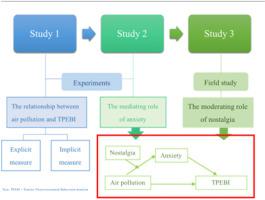Journal of Cleaner Production ( IF 9.7 ) Pub Date : 2021-09-10 , DOI: 10.1016/j.jclepro.2021.128952 Changcheng Wang 1 , Liuna Geng 1 , Julián D. Rodríguez-Casallas 1

|
Climate change has been positioned as one of the most severe environmental threats facing us today. To address climate change, enhancing climate change risk perception and reducing climate change inaction are both critical. However, little research has touched on the issue of whether climate change risk perception is linked to climate change inaction in a negative manner. Moreover, there is still much unknown about the complex process behind this relationship, and the boundary conditions of this process awaits clarification. To address these gaps in the literature, two studies were conducted to first confirm the possible negative association between climate change risk perception and climate change inaction and, second, explore through a parallel mediational model whether climate change belief and environmental efficacy mediate simultaneously the relation between climate change risk perception and climate change inaction. Finally, a moderated sequential mediational model was used to investigate whether climate change risk perception is associated with climate change inaction through the sequential mediation of climate change belief and environmental efficacy, and to clarify underlying boundary conditions by analyzing the moderation of mindfulness as well. The results showed that, as expected, higher levels of climate change risk perception were related to less climate change inaction, and this relation was mediated by enhanced climate change belief and heightened environmental efficacy in a sequential manner. Furthermore, the sequential mediating effect of climate change belief and environmental efficacy was stronger among those who had a higher level of mindfulness. These findings advance the emerging research on climate change inaction by elucidating the mechanisms underlying the effect of climate change risk perception. Moreover, they extend the Domain-Context-Behavior (DCB) model and Gateway belief model (GBM). In practice, climate change education and climate change inaction interventions can be designed and implemented to nudge clean production, green supply chain and green consumption, which finally contribute to sustainable development and the ‘green transformation’ of society.
中文翻译:

更高的气候变化风险认知如何以及何时促进更少的气候变化无所作为
气候变化已被定位为当今我们面临的最严重的环境威胁之一。应对气候变化,增强气候变化风险感知和减少气候变化不作为都至关重要。然而,很少有研究涉及气候变化风险感知是否与气候变化不作为以消极方式相关联。而且,这种关系背后的复杂过程还有很多未知,这个过程的边界条件有待澄清。为了解决文献中的这些差距,进行了两项研究,首先确认气候变化风险感知与气候变化不作为之间可能存在负相关,其次,通过平行中介模型探索气候变化信念和环境功效是否同时调节气候变化风险感知和气候变化不作为之间的关系。最后,通过气候变化信念和环境功效的序列中介,使用适度的序列中介模型来研究气候变化风险感知是否与气候变化不作为相关,并通过分析正念的适度来阐明潜在的边界条件。结果表明,正如预期的那样,较高水平的气候变化风险感知与较少的气候变化不作为有关,而这种关系是由增强的气候变化信念和依次提高的环境效能所介导的。此外,在正念水平较高的人群中,气候变化信念和环境功效的顺序中介作用更强。这些发现通过阐明气候变化风险感知影响的潜在机制,推进了对气候变化不作为的新兴研究。此外,它们扩展了域-上下文-行为 (DCB) 模型和网关信念模型 (GBM)。在实践中,可以设计和实施气候变化教育和气候变化不作为干预措施,以推动清洁生产、绿色供应链和绿色消费,最终有助于可持续发展和社会的“绿色转型”。这些发现通过阐明气候变化风险感知影响的潜在机制,推进了对气候变化不作为的新兴研究。此外,它们扩展了域-上下文-行为 (DCB) 模型和网关信念模型 (GBM)。在实践中,可以设计和实施气候变化教育和气候变化不作为干预措施,以推动清洁生产、绿色供应链和绿色消费,最终有助于可持续发展和社会的“绿色转型”。这些发现通过阐明气候变化风险感知影响的潜在机制,推进了对气候变化不作为的新兴研究。此外,它们扩展了域-上下文-行为 (DCB) 模型和网关信念模型 (GBM)。在实践中,可以设计和实施气候变化教育和气候变化不作为干预措施,以推动清洁生产、绿色供应链和绿色消费,最终有助于可持续发展和社会的“绿色转型”。









































 京公网安备 11010802027423号
京公网安备 11010802027423号